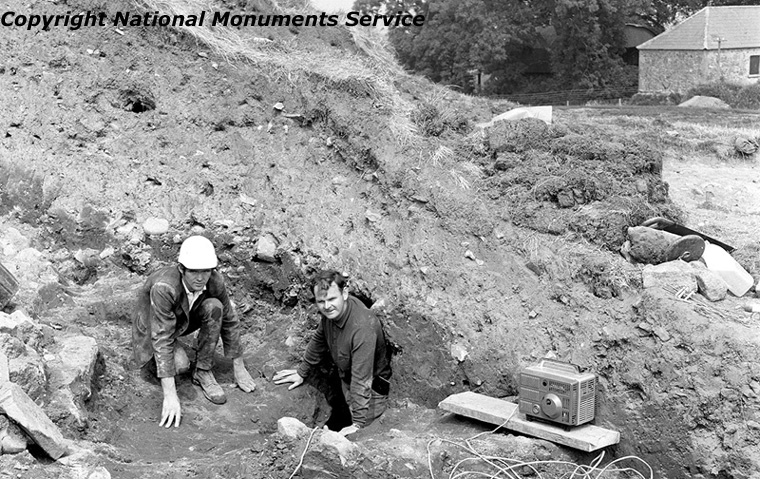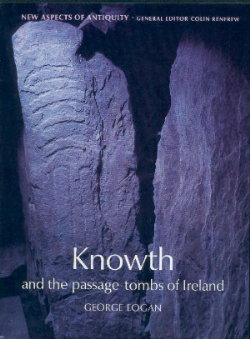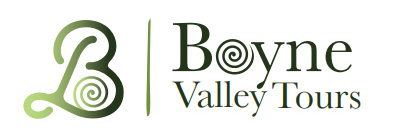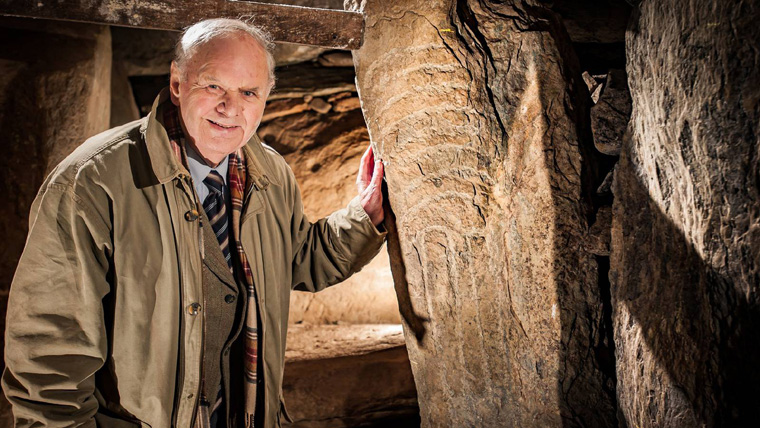George Eogan (1930-2021)
 George Eogan
was an Irish Archaeologist
with particular interest in the Neolithic and Late Bronze Ages. A first degree at University College Dublin was followed
by a doctoral thesis on Irish Late Bronze Age swords at Trinity College Dublin under Frank Mitchell.
In the 1950's he worked with P.J. Hartnett on the Neolithic passage tomb at Fourknocks,
and with Seán P. Ó Ríordáin at the Mound of the Hostages on the Hill of Tara.
George Eogan
was an Irish Archaeologist
with particular interest in the Neolithic and Late Bronze Ages. A first degree at University College Dublin was followed
by a doctoral thesis on Irish Late Bronze Age swords at Trinity College Dublin under Frank Mitchell.
In the 1950's he worked with P.J. Hartnett on the Neolithic passage tomb at Fourknocks,
and with Seán P. Ó Ríordáin at the Mound of the Hostages on the Hill of Tara.
He was the Director of the Knowth Research Project and excavated at Knowth for more than 40 years as part of his investigation of the Passage Tomb builders in Ireland and Western Europe. Professor Eogan was a native of Nobber, Co. Meath in Ireland and has taught and lectured extensively on Irish archaeology.
Discovering the Dark Wonders of Knowth
Initially there was no evidence that the mound contained tombs. Having begun to excavate on its northern side, we gradually moved westward and by the end kerb, but these were suspected at the time to be associated with one of the nearby small passage-tombs. Leaving the site in August of that year, we had no definite clue as to the location of an entrance into the mound.Read more from The Irish Times - November 1986.
Knowth, A Mecca for Prehistoric Pilgrims
At Knowth, however, the orientation of the great mound suggests that there could have been two ceremonies at different times, the vernal equinox on March 20th or 21st, and the autumnal equinox on September 22nd or 23rd. at these times, the sun rises and sets directly in the east and west, while day and night have equal lengths. The spring equinox represents the beginning of the growing season, and the harvest would have been gathered at the autumnal equinox.Read more from The Irish Times - November 1986.
Knowth Excavations
The excavation at Knowth is one of the greatest pieces of archaeology of our time. On June 18th 2002 it was my privilege to be there with some students forty years to the day from the start of the excavation. After touring the site, George Eogan invited us over to a large caravan in the farmyard across the road to join the anniversary celebrations with Knowth trowellers, workmen and other local folk.This year I returned to Ireland to see George again, and to find out more about George Eogan. Why did he choose to spend the greater part of his life excavating at one site? And what was it like to be the first person in a thousand years to enter a great Neolithic passage tomb?
Read more from Current Archaeology - October 2003.
Knowth - Secrets from the grave
Nearly 50 years ago, archaeologists began excavating at Knowth near Newgrange - and the site has yet to give up all its secrets.'The first day we went in, we went up the passage. When we got in towards the end, the passage became difficult, but there seemed to be a void at the top and I crawled up with a flashlight and walked until I came to the end of the passage.
Read more from The Irish Times - 2008.
George Eogan - The Irish Times - June 2012
You've been working at the site, on and off, for 50 years now. Is it slow, deliberate work or have there been any dramatic Tutankhamun-esque breakthroughs? There were two such moments, in fact. Once, in 1967, we discovered a small hole on the western side of the mound. I uttered an exclamation, took my flash lamp and entered the passage. This, in turn, led to a very impressive chamber. The whole thing was over 100ft in length. It was very dramatic. The next year, we discovered a similar chamber on the eastern side. It was about 20ft high and extremely well constructed.Read more from The Irish Times - June 2012.
Obituary - The Irish Times, 25 November 2021
Prof George Eogan (1930 - 2021), the internationally renowned archaeologist and former professor of archaeology at University College Dublin (UCD) whose dedicated excavations at Knowth helped bring international attention to the monuments of the World Heritage Site at Brú na Boínne has died aged 91.Dr Pat Wallace, former director of the National Museum said Eogan was "the most influential archaeologist that Ireland has ever produced".
Eogan was a leading scholar of Neolithic and Bronze Age Europe with a particular focus on the bronze and gold objects of these periods. His research into the Neolithic passage tombs of Ireland and western Europe saw him direct over 40 years of archaeological excavations at the Knowth passage tombs in County Meath.
He was one of the first people in modern times to enter the two great passage tombs of the Great Mound at Knowth. In a later interview, he said, "to have had the privilege of entering these tombs is for me one of the great events that one could ever experience". These two tombs which he and his team discovered in 1967 and 1968 are the longest passage tombs ever found in western Europe.
Eogan went on to discover many other smaller tombs and uncover an open air gallery of ancient megalithic art, the abundance and quality of which is unparalleled anywhere else in the world. The decorated macehead found in the eastern tomb at Knowth - which is on permanent display in the National Museum - is one of the finest artefacts ever recovered from a Neolithic site.
In 1991, when Knowth opened to the public for the first time, Eogan helped train the Office of Public Works guides at the site. That same year, he became the founding chairman of the Discovery Programme, a Heritage Council funded initiative which promotes archaeological research and education. In 2007, he was awarded the Royal Irish Academy Gold Medal in the Humanities in 2007.

John Rock (left) and George Eogan (right) at the opening of the Eastern tomb at Knowth in August 1969
Prestigious bodies
Throughout his long career, he was a member of many prestigious bodies including Academia Europa, the German Archaeological Institute and the Society of Antiquaries of London. He served on the Archaeology Committee of the European Science Foundation and the Higher Education Committee of the Council of Europe. He also served as an adviser of the National Monuments Advisory Council and the Historic Monuments Council in Northern Ireland. He travelled to conferences, museums and archaeological sites across Europe.Always keen that the structures and supports were in place for archaeologists, Eogan was the first chairperson of the Irish Association of Professional Archaeologists [now the Institute of Archaeologists of Ireland]. He was also, according to Wallace, "the star witness" in the High Court case which declared the Wood Quay Viking site a national monument even though Dublin City Council offices were subsequently built on it. In recognition of his leadership in archaeology, the then taoiseach, Charles J Haughey, appointed him as an independent senator to Seanad Éireann in 1987, a post he held for two years.
Unpretentious in manner and sociable by nature, he was as comfortable talking about archaeology to tour bus drivers as he was to academics, diplomats or politicians. His layperson's guide, Knowth and the Passage Tombs of Ireland (Thames and Hudson, 1986) reached a wide audience at home and abroad. His other books include Catalogue of Irish Bronze Swords (1965), The Hoards of the Irish Later Bronze Age (1983), The Accomplished Art: Gold and Gold-working in Britain and Ireland during the Bronze Age (1994) and the Socketed Bronze Axes in Ireland (2000).
George Eogan grew up in Nobber, Co Meath, where his early interest in archaeology was whetted by a national school teacher who had a degree in archaeology. He left school following his Group Cert at Nobber Technical School and worked at various jobs while pursuing his interest in archaeology by going on outings with the Royal Society of Antiquities. In the early 1950s, he got work as a labourer on archaeological digs for the National Museum of Ireland. Paddy Hartnett, an archaeologist working for the National Museum, recognised and encouraged his enthusiasm and when Hartnett became the first archaeologist employed by Bord Fáilte to promote archaeological tourism, Eogan became his assistant.
Palestine and Jordan
At this point, Eogan enrolled as a night student at University College Dublin (UCD) to study for a degree in archaeology and English.Upon his graduation from UCD, he studied for his PhD under Prof Frank Mitchell at Trinity College Dublin. As a trainee archaeologist in the early 1960s, Eogan also won a scholarship with the British School of Archaeology in Jerusalem to work on archaeological sites in Palestine and Jordan.
He worked as a researcher at TCD, the University of Oxford and Queen's University Belfast before being appointed as a lecturer in archaeology at UCD in 1965. He met his wife to be, Fiona Stephens at UCD when, as a social science student, she took his classes in archaeology. The couple were married in 1969 and every year decamped with their young children to spend the summer in the Boyne Valley. Their son, James Eogan - who is also an archaeologist - remembers how the family stayed from June to August in Townley Hall alongside international students where his mother cooked and looked after everyone. These included a stream of visiting artists, poets, politicians and ambassadors. It enabled his father to concentrate on working on excavations with his team of professional archaeologists, volunteers and local workmen.
George became professor of archaeology at UCD in 1979 and continued in that role until his retirement in 1995. Popular among students for his passion for archaeology and his wry sense of humour, he mentored numerous archaeologists who then went on to add to the knowledge of prehistoric Ireland. He cycled from his home in Rathgar to the Belfield campus in all weathers and was a reluctant retiree. In fact, he unsuccessfully took a High Court challenge against UCD, seeking the right to continue working until he was 70. Following his official retirement from UCD, he continued his research interests for over 20 years. In recognition of his career and achievements, his colleagues edited a book in his honour entitled, From Megaliths to Metals: Essays in Honour of George Eogan (Oxbow Books, 2004).
An ardent fan of the GAA, Prof Eogan maintained links with his native county and wrote regular articles for the Meath Archaeological and Historical Society Journal, Riocht na Midhe. He often said that one of his greatest honours was when he was named Meath Personality of the Year in 2003. In 2016, President Michael D Higgins officially opened the George Eogan Cultural and Heritage Centre in Nobber in honour of the town's own archaeologist. In 2020, Eogan's library was donated to the National Museum and his papers were donated to the UCD archives. The last monograph (which covers megalithic art) on his excavations at Knowth will be published by the Royal Irish Academy in spring 2022.
Knowth and the passage-tombs of Ireland
 Knowth and the passage-tombs of Ireland - New Aspects of Antiquity series, 1986.
Knowth and the passage-tombs of Ireland - New Aspects of Antiquity series, 1986.
George Eogan describes in vivid detail the dramatic discovery of not one but two tombs within the central mound, their narrow passages and decorated chambers hitherto unseen by man since ancient times.
Built back to back, the tombs, George Eogan argues, were used for burials and very likely for ceremonies celebrating the rising and setting sun at spring and autumn equinox. Ritual deposits in the chambers included an exquisitely carved flint mace-head, hailed by experts as one of the finest pieces ever to come out of prehistoric Ireland.
Purchase at Amazon.com or Amazon.co.uk
Boyne Valley Private Day Tour
 Immerse yourself in the rich heritage and culture of the Boyne Valley with our full-day private tours.
Visit Newgrange World Heritage site, explore the Hill of Slane, where Saint Patrick famously lit the Paschal fire.
Discover the Hill of Tara, the ancient seat of power for the High Kings of Ireland.
Book Now
Immerse yourself in the rich heritage and culture of the Boyne Valley with our full-day private tours.
Visit Newgrange World Heritage site, explore the Hill of Slane, where Saint Patrick famously lit the Paschal fire.
Discover the Hill of Tara, the ancient seat of power for the High Kings of Ireland.
Book Now
Home
| Newgrange
| Knowth
| Dowth
| Hill of Tara
| Fourknocks
| Loughcrew
| More Places
| Labyrinths
| Local Info
| Art Works
| Articles
| Images
| Books
| Links
| Boyne Valley Tours
| Contact

